K8s Deployment Sample 3: JMS Sender/Receiver¶
Let's define a JMS (sender and receiver) scenario using ESB Micro Integrator and deploy it on your Kubernetes environment.
Prerequisites¶
- Install and set up ESB Integration Studio.
- Install a Kubernetes cluster and v1.11+ client. Alternatively, you can run Kubernetes locally via Minikube.
- Install Docker.
-
Install the Kubernetes API Operator.
-
Deploy an ActiveMQ pod inside your Kubernetes cluster.
Step 1 - Create the integration solution¶
Follow the steps given below.
- Open ESB Integration Studio.
-
In the Getting Started view, click New Integration Project

-
In the New Integration Project dialog box, give a name for the integration project and select the following check boxes: Create ESB Configs, Create Composite Exporter, and Create Kubernetes Exporter.
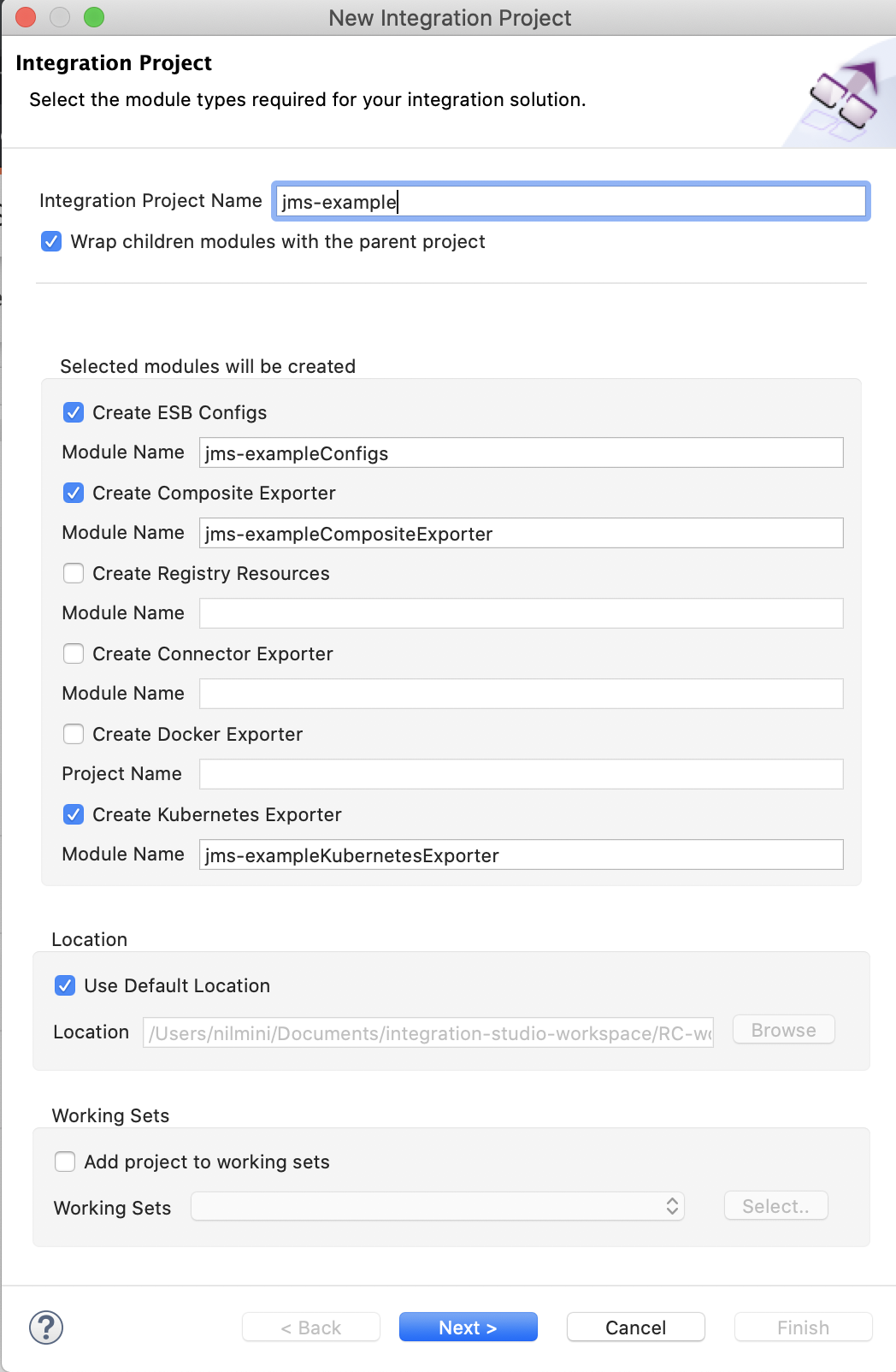
-
Click Next and enter the following details for your Kubernetes Exporter.
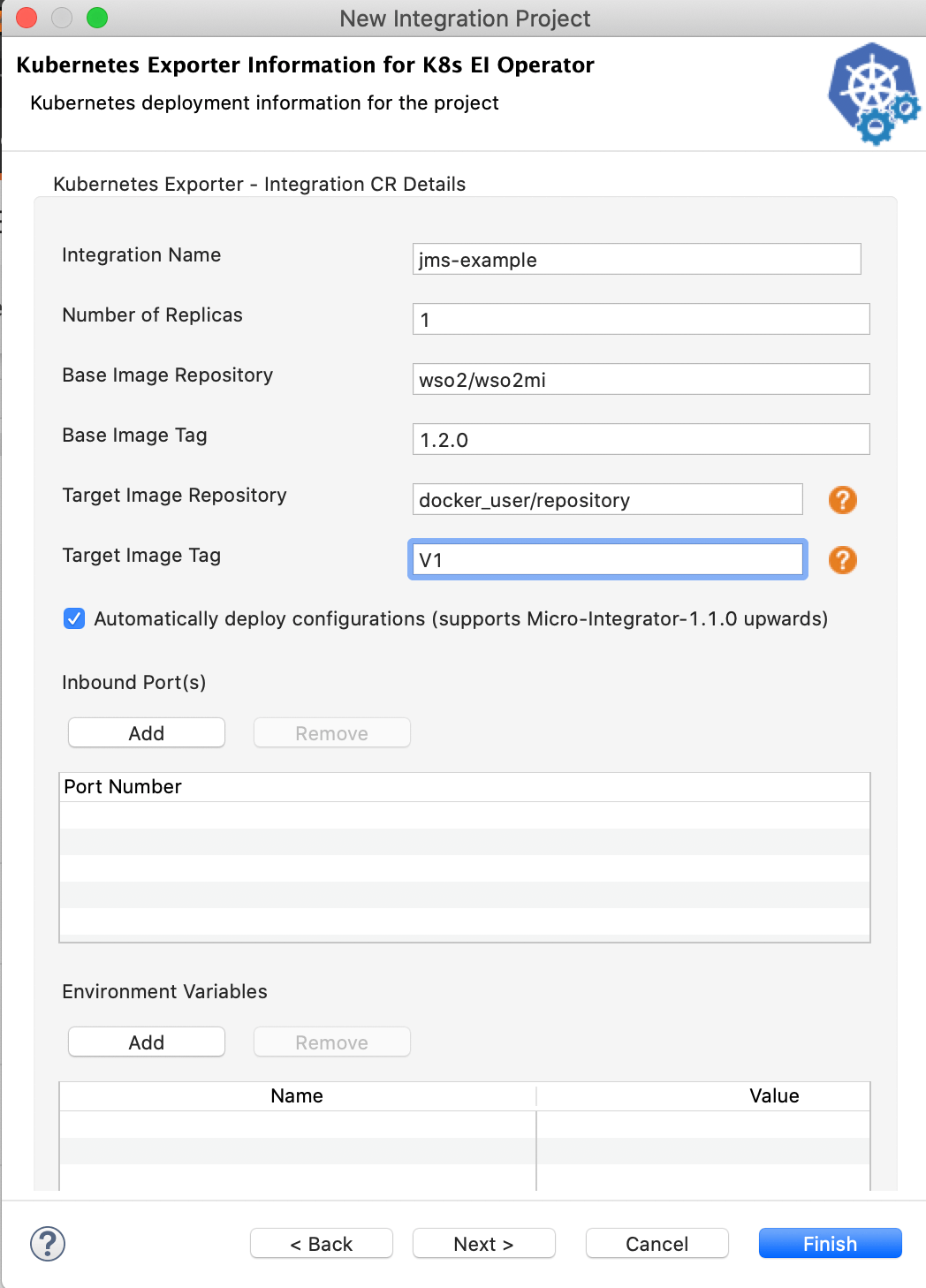
Parameter Description Kubernetes Exporter Name Give a unique name for the project. Integration Name This name will be used to identify the integration solution in the kubernetes custom resource. Let's use jms-exampleas the integration name for this example.Number of Replicas Specify the number of pods that should be created in the kubernetes cluster. Base Image Repository Specify the base Micro Integrator Docker image for your solution. For this example, let's use the Micro Integrator docker image from the MWARE public docker registry: mware/esb2mi. Note that the image value format should be 'docker_user_name/repository_name'. Base Image Tag Give a tag name for the base Docker image. Target Image Repository The Docker repository to which the Docker image will be pushed: 'docker_user_name/repository_name'. Target Image Tag Give a tag name for the Docker image. -
Add the following proxy service configuration to your project. This service listens to messages from ActiveMQ and publishes to another queue in ActiveMQ.
-
Right-click ESB Config in the project explorer, go to New -> Proxy Service and create a custom proxy service named
JmsSenderListener.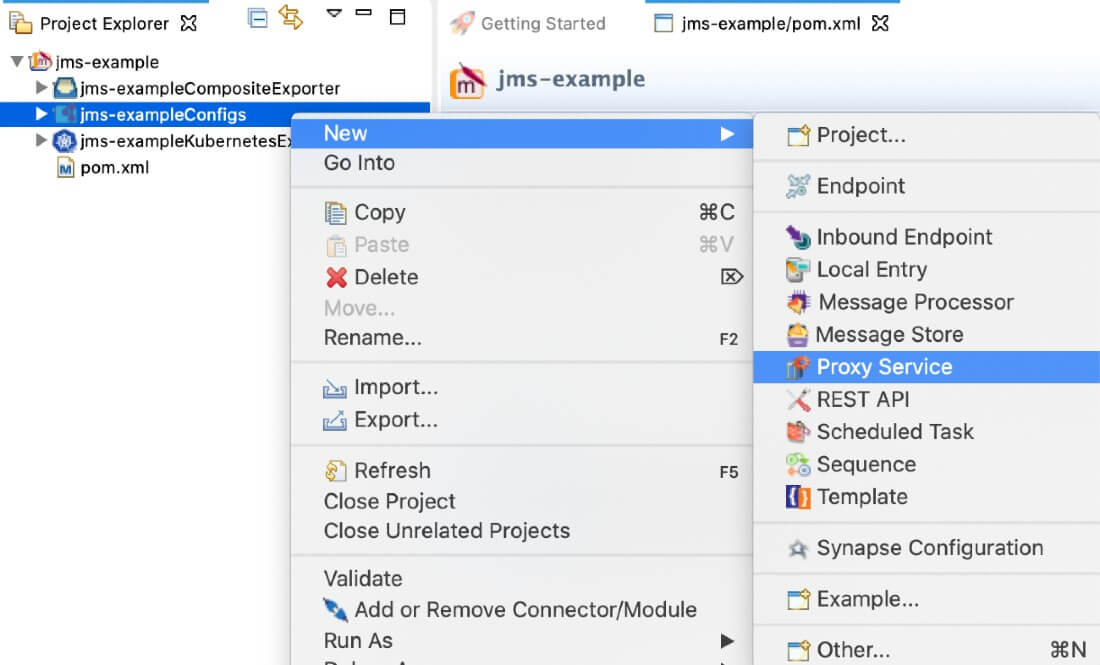
-
You can then use the Source View to copy the following configuration.
Tip
Be sure to update the tcp://localhost:61616 URL given below with the actual/connecting URL that will be reachable from the Kubernetes pod.
<?xml version="1.0" encoding="UTF-8"?> <proxy name="JmsSenderListener" startOnLoad="true" transports="jms" xmlns="http://ws.apache.org/ns/synapse"> <target> <inSequence> <send> <endpoint> <address uri="jms:/secondQueue?transport.jms.ConnectionFactoryJNDIName=QueueConnectionFactory&java.naming.factory.initial=org.apache.activemq.jndi.ActiveMQInitialContextFactory&java.naming.provider.url=failover:(tcp://localhost:61616,tcp://localhost:61617)?randomize=false&transport.jms.DestinationType=queue"> <suspendOnFailure> <initialDuration>-1</initialDuration> <progressionFactor>-1</progressionFactor> <maximumDuration>0</maximumDuration> </suspendOnFailure> <markForSuspension> <retriesBeforeSuspension>0</retriesBeforeSuspension> </markForSuspension> </address> </endpoint> </send> </inSequence> <outSequence/> <faultSequence/> </target> <parameter name="transport.jms.SessionAcknowledgement">AUTO_ACKNOWLEDGE</parameter> <parameter name="transport.jms.Destination">$SYSTEM:destination</parameter> <parameter name="transport.jms.ConnectionFactoryType">firstQueue</parameter> <parameter name="transport.jms.ContentType">$SYSTEM:contenttype</parameter> <parameter name="java.naming.provider.url">$SYSTEM:jmsurl</parameter> <parameter name="transport.jms.SessionTransacted">false</parameter> <parameter name="transport.jms.ConnectionFactoryJNDIName">$SYSTEM:jmsconfac</parameter> <parameter name="transport.jms.UserName">$SYSTEM:jmsuname</parameter> <parameter name="transport.jms.Password">$SYSTEM:jmspass</parameter> </proxy>
-
-
Open the integration_cr.yaml file inside the Kubernetes exporter and add the environment variables as shown below. These values will be injected to the parameters defined in the proxy service.
Tip
Be sure to update the tcp://localhost:61616 URL in the above configuration with the actual/connecting URL that will be reachable from the Kubernetes pod.
--- apiVersion: "wso2.com/v1alpha2" kind: "Integration" metadata: name: "jms" spec: image: "Docker/image/path/to/the/JMSSenderListner" deploySpec: minReplicas: 1 expose: passthroPort: 8290 env: - name: "jmsconfac" value: "TopicConnectionFactory" - name: "jmsuname" value: "admin" - name: "destination" value: "queue" - name: "jmsurl" value: "tcp://localhost:61616" - name: "jmspass" value: "admin" - name: "contenttype" value: "application/xml"
Finally, the created Maven Multi Module project should look as follows:
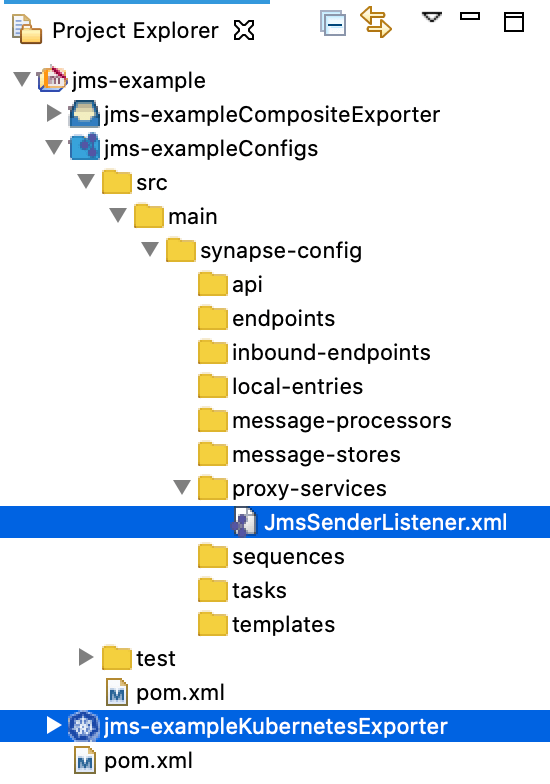
Step 2 - Update JMS configurations¶
- Uncomment the following two commands in the Dockerfile inside the Kubernetes project.
COPY Libs/*.jar $WSO2_SERVER_HOME/lib/ COPY Conf/* $WSO2_SERVER_HOME/conf/ - Download Apache ActiveMQ.
-
Copy the following client libraries from the
<ACTIVEMQ_HOME>/libdirectory to the<MAVEN_MULTI_MODULE>/<KUBERNETES_PROJECT>/Libdirectory.ActiveMQ 5.8.0 and above
- activemq-broker-5.8.0.jar
- activemq-client-5.8.0.jar
- activemq-kahadb-store-5.8.0.jar
- geronimo-jms_1.1_spec-1.1.1.jar
- geronimo-j2ee-management_1.1_spec-1.0.1.jar
- geronimo-jta_1.0.1B_spec-1.0.1.jar
- hawtbuf-1.9.jar
- Slf4j-api-1.6.6.jar
- activeio-core-3.1.4.jar (available in the
/lib/optional directory)
Earlier version of ActiveMQ
- activemq-core-5.5.1.jar
- geronimo-j2ee-management_1.0_spec-1.0.jar
- geronimo-jms_1.1_spec-1.1.1.jar
-
Open the
deployment.tomlfile in your Kubernetes project and add the following content to enable the JMS sender and listener:Tip
Be sure to update the tcp://localhost:61616 URL in the above configuration with the actual/connecting URL that will be reachable from the Kubernetes pod.
[server] hostname = "localhost" [keystore.primary] file_name = "wso2carbon.jks" password = "wso2carbon" alias = "wso2carbon" key_password = "wso2carbon" [truststore] file_name = "client-truststore.jks" password = "wso2carbon" alias = "symmetric.key.value" algorithm = "AES" [[transport.jms.listener]] name = "default" parameter.initial_naming_factory = "org.apache.activemq.jndi.ActiveMQInitialContextFactory" parameter.provider_url = "tcp://localhost:61616" parameter.connection_factory_name = "QueueConnectionFactory" parameter.connection_factory_type = "queue" [[custom_transport.sender]] protocol = "jms" class="org.apache.axis2.transport.jms.JMSSender"
Step 3 - Build and Push the Docker image¶
Note
Be sure to start your Docker instance before building the image. If Docker is not started, the build process will fail.
There are two ways to build a Docker image of the integration solution and push it to your Docker registry:
-
Using Maven:
Before you begin
You need Maven 3.5.2 or a later version when you build the Docker image manually (without using ESB Integration Studio).
- Open a terminal and navigate to the integration project.
-
Execute the following command.
Be sure to specify the user name and password of the correct Docker registry.
mvn clean install -Dmaven.test.skip=true -Ddockerfile.username={username} -Ddockerfile.password={password}
This will build the Docker image and then push it to the specified Docker registry.
-
Using ESB Integration Studio:
- Open the pom.xml file in the Kubernetes exporter.
-
Ensure that the composite exporter is selected under Dependencies and click Build & Push.
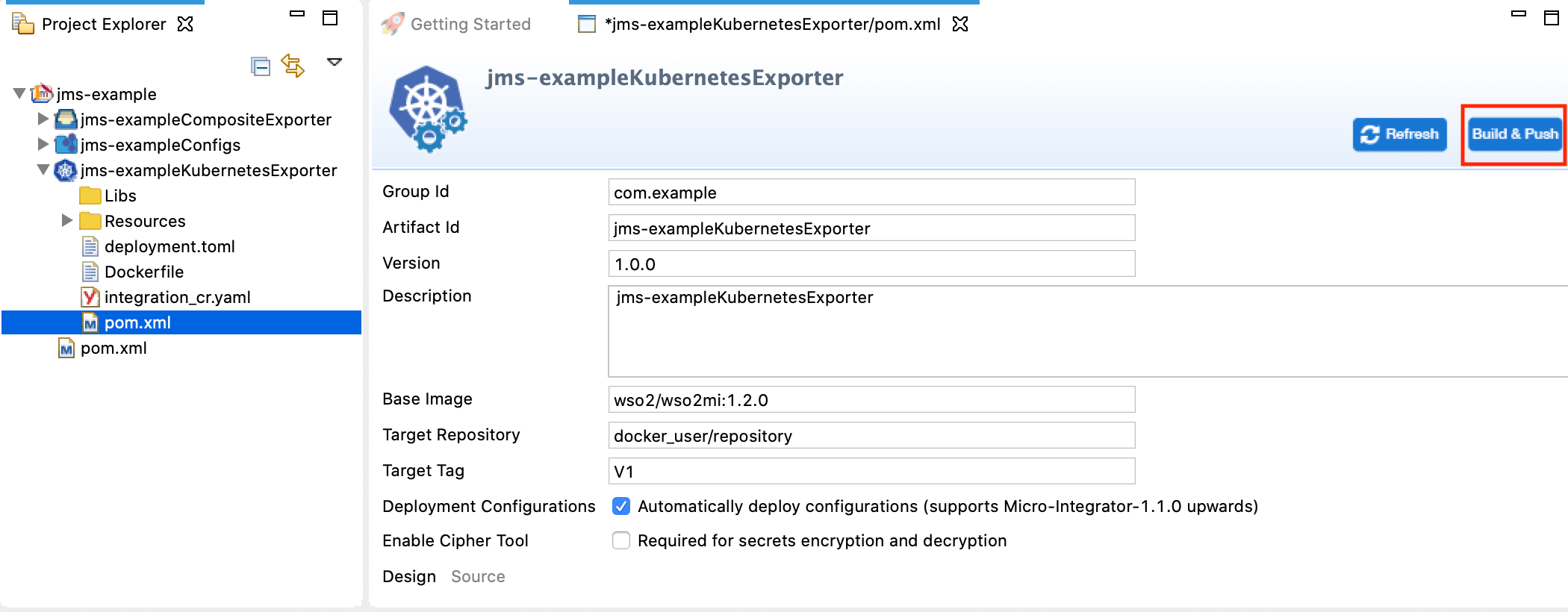
-
In the dialog box that opens, enter the credentials of your Docker registry to which the image should be pushed.
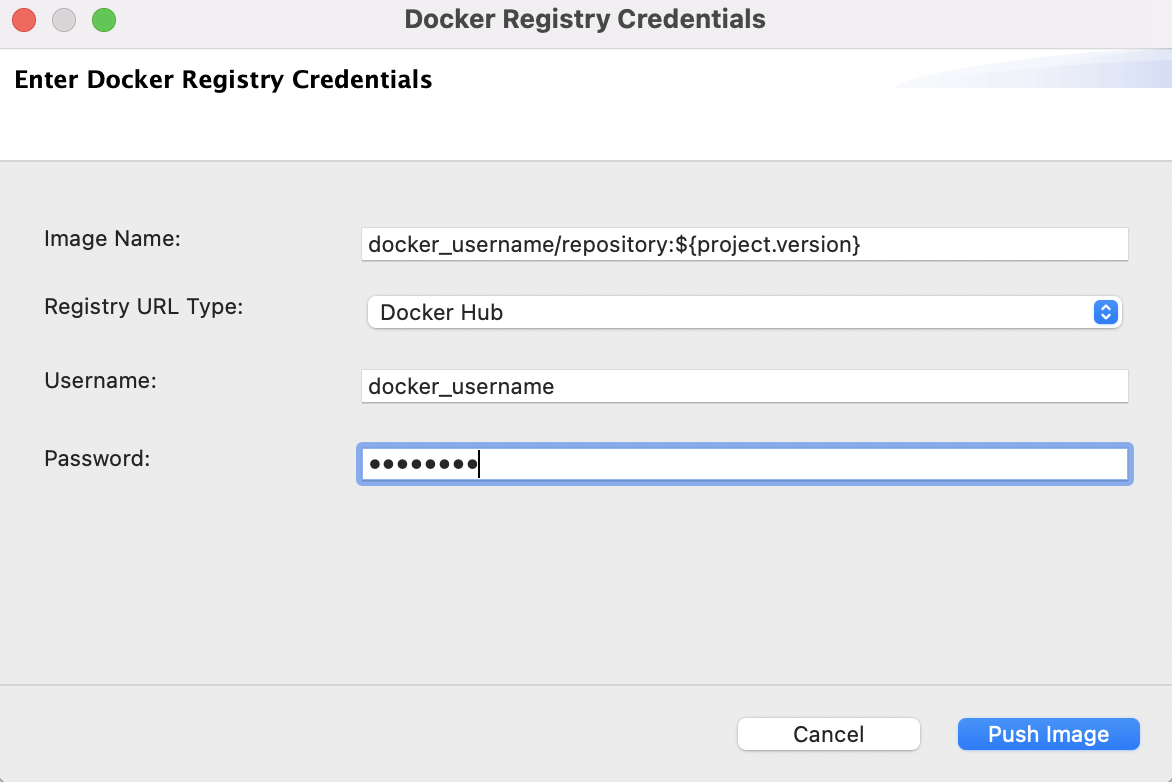
-
Click Push Image.
Run the docker image ls command to verify that the Docker image is created.
Step 4 - Deploy the solution in K8s¶
Info
Before you begin, the API Kubernetes Operator should be installed in your Kubernetes environment.
Follow the steps given below:
- Open the
integration_cr.yamlfile from the Kubernetes project in ESB Integration Studio. - See that the integration details of the
jms-examplesolution is updated. - Open a terminal, navigate to the location of your
integration_cr.yamlfile, and execute the following command to deploy the integration solution into the Kubernetes cluster:kubectl apply -f integration_cr.yaml
When the integration is successfully deployed, it should create the jms-example integration, jms-example-deployment, jms-example-service, and ei-operator-ingress as follows:
Tip
The ei-operator-ingress is not created if you have disabled the ingress controller.
kubectl get integration
NAME STATUS SERVICE-NAME AGE
jms-example Running 2m
kubectl get deployment
NAME READY UP-TO-DATE AVAILABLE AGE
jms-example-deployment 1/1 1 1 2m
kubectl get services
NAME TYPE CLUSTER-IP EXTERNAL-IP PORT(S) AGE
jms-example-service ClusterIP 10.101.107.154 <none> 8290/TCP 2m
kubernetes ClusterIP 10.96.0.1 <none> 443/TCP 2d
k8s-api-operator ClusterIP 10.98.78.238 <none> 443/TCP 1d
kubectl get ingress
NAME HOSTS ADDRESS PORTS AGE
api-operator-ingress wso2ei.ingress.wso2.com 10.0.2.15 80, 443 2mThis will create a new queue called queue in ActiveMQ.
Step 5 - Test the deployment¶
Send a message to this queue. The proxy service you added in step 3 above will listen to this message and send that message to a new queue called secondQueue.
Top